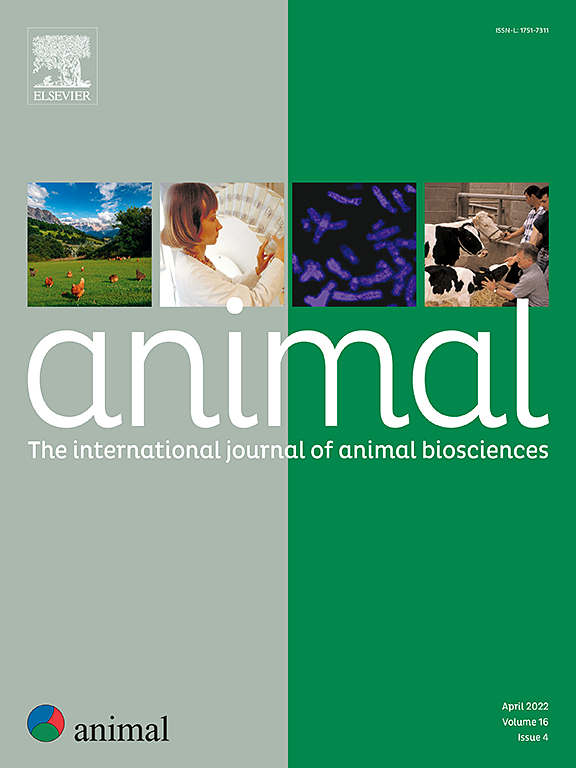生长速度主要通过遗传或日粮来决定肉鸡福利的结果
IF 4
2区 农林科学
Q1 AGRICULTURE, DAIRY & ANIMAL SCIENCE
引用次数: 0
摘要
肉鸡生产系统有向更高福利要求发展的趋势,这种生产系统通常使用多种因素来提高肉鸡福利。这使得很难弄清楚改善是由于住房条件,饮食,遗传还是这些因素的综合。因此,福利的差异在多大程度上可以归因于品种(即遗传)、生长速度(即饮食)或两者之间的相互作用,仍然是未知的。我们比较了快速肉鸡(Ross 308, R)、中等肉鸡(Ranger Classic, RC)和生长较慢的肉鸡(Hubbard JA757, H)接受不同蛋白质(BP)平衡含量(即80%、90%和100%)的饲粮。我们确定了三个目标体重(TBW、0.2、1.2和2.4 kg)对行为、行为测试反应和产仔质量的影响,以及TBW 2.6 kg时福利评分和产仔DM含量的影响。试验采用3 × 3因子设计,每个处理4个重复(栏)(共36个栏)。我们假设,降低生长速度将改善所有品种的福利,如果它们具有可比的生长速度,品种的福利不会有所不同。事实上,降低生长率提高了所有品种的飞节烧伤分数。R型肉鸡的清洁评分也有所改善,RC型肉鸡的步态评分也有所改善。降低生长速度增加了R型肉鸡在自由空间试验中接近人类和新物体并表现出奔跑行为的数量,而降低了RC型肉鸡接近人类并表现出舒适行为的数量,对H型肉鸡的行为没有影响。此外,R型肉鸡的窝产仔质量(湿性和DM)得到改善,H型肉鸡的窝产仔质量(DM)降低,生长速率降低,而RC型肉鸡的窝产仔质量未受生长速率的影响。因此,降低生长速度(即降低日粮中的BP)可以提高所有品种的福利,但不同品种在行为和产仔质量方面的反应不同,与中、慢生长肉鸡相比,速生肉鸡的受益效果更大。在生长速度相当的品种之间(R80 vs RC100和RC80 vs H100),除了R80在清洁度和步态评分方面得分更高(仅雄性)和产仔DM含量高于RC100外,几乎没有发现任何行为、福利评分和产仔质量差异。这些发现表明,无论是通过遗传还是通过饲粮,生长速度都是决定肉鸡福利的主要因素。本文章由计算机程序翻译,如有差异,请以英文原文为准。
Growth rate, either through genetics or diet, mainly determines the outcome concerning broiler welfare
There is a trend towards broiler production systems with higher welfare requirements, which often use a combination of factors to improve broiler welfare. This makes it difficult to entangle whether improvements are due to housing conditions, diet, genetics or a combination of these factors. Therefore, it remains unknown to what extent differences in welfare can be attributed to breed (i.e., genetics), growth rate (i.e., diet) or the interaction between the two. We compared fast- (Ross 308, R), medium- (Ranger Classic, RC) and slower-growing broilers (Hubbard JA757, H) receiving diets differing in balanced protein (BP) content (i.e., 80, 90 and 100%). We identified effects on behaviour, responses to behavioural tests and litter quality at three target body weights (TBWs, 0.2, 1.2 and 2.4 kg), and welfare scores and litter DM content at TBW 2.6 kg. The experiment had a 3 × 3 factorial design with four replicates (pens) per treatment (a total of 36 pens). We hypothesised that reducing the growth rate will improve the welfare of all breeds and that breeds will not differ in welfare if they have a comparable growth rate. Indeed, reducing the growth rate improved hock burn scores in all breeds. R broilers also had improved cleanliness scores and RC broilers improved gait scores. Reducing the growth rate increased the number of R broilers approaching a human and novel object and showing running behaviour in the free-space test, while it reduced the number of RC broilers approaching a human and showing comfort behaviour and did not affect behaviour in H broilers. In addition, litter quality was improved for R broilers (wetness and DM), while reduced for H broilers (DM) with reduced growth rate, and no effects of growth rate on litter quality were found for RC broilers. Thus, reducing growth rate (i.e., reducing BP in diets) improves welfare in all breeds, but breeds did respond differently concerning behaviour and litter quality, with more beneficial effects for fast-growing broilers compared to medium- and slower-growing broilers. Hardly any differences in behaviour, welfare scores and litter quality were found between breeds when they had a comparable growth rate (R80 vs RC100 and RC80 vs H100), except for R80 having better scores for cleanliness and gait scores (only males) and higher litter DM content compared to RC100. These findings suggest that growth rate, either through genetics or diet, is mainly determining the outcome concerning broiler welfare.
求助全文
通过发布文献求助,成功后即可免费获取论文全文。
去求助
来源期刊

Animal
农林科学-奶制品与动物科学
CiteScore
7.50
自引率
2.80%
发文量
246
审稿时长
3 months
期刊介绍:
Editorial board
animal attracts the best research in animal biology and animal systems from across the spectrum of the agricultural, biomedical, and environmental sciences. It is the central element in an exciting collaboration between the British Society of Animal Science (BSAS), Institut National de la Recherche Agronomique (INRA) and the European Federation of Animal Science (EAAP) and represents a merging of three scientific journals: Animal Science; Animal Research; Reproduction, Nutrition, Development. animal publishes original cutting-edge research, ''hot'' topics and horizon-scanning reviews on animal-related aspects of the life sciences at the molecular, cellular, organ, whole animal and production system levels. The main subject areas include: breeding and genetics; nutrition; physiology and functional biology of systems; behaviour, health and welfare; farming systems, environmental impact and climate change; product quality, human health and well-being. Animal models and papers dealing with the integration of research between these topics and their impact on the environment and people are particularly welcome.
 求助内容:
求助内容: 应助结果提醒方式:
应助结果提醒方式:


